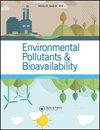Occurrence and levels of pesticides in South Lebanon water
Q3 Chemical Engineering
引用次数: 20
Abstract
This study reviews the detection of pesticides in different surface and groundwater samples collected from South Litani region in South Lebanon during 2012. These have been analyzed using an optimized and validated solid phase extraction method followed by gas chromatography coupled with mass spectrometry. Organochlorine and organophosphate pesticides were mostly noted at levels below the recommended value for individual pesticide in water except pirimiphos-methyl that was recorded at 300.87 ng L−1 in groundwater sample, designated for drinking water and collected in February. DDE concentration exceeded 100 ng L−1 in both surface and groundwater in October. The reported results represent the first Lebanese statistical data illustrating the quantification of pesticides in water over a period of time. More importantly, it draws attention to the need of pesticides’ monitoring programs in the Lebanese water resources.黎巴嫩南部水域杀虫剂的出现和水平
本研究回顾了2012年黎巴嫩南部利塔尼地区不同地表水和地下水样品中农药的检测情况。采用优化和验证的固相萃取法,然后采用气相色谱-质谱联用分析。除2月份收集的指定用于饮用水的地下水样品中甲基吡虫磷的含量为300.87 ng L−1外,大多数有机氯和有机磷农药的含量低于单个农药的建议值。10月份地表水和地下水DDE浓度均超过100 ng L−1。报告的结果是黎巴嫩第一次统计数据,说明了一段时间内水中农药的量化情况。更重要的是,它引起了人们对黎巴嫩水资源中农药监测项目的关注。
本文章由计算机程序翻译,如有差异,请以英文原文为准。
求助全文
约1分钟内获得全文
求助全文
来源期刊
CiteScore
1.62
自引率
0.00%
发文量
0
审稿时长
1 months
期刊介绍:
Chemical Speciation & Bioavailability ( CS&B) is a scholarly, peer-reviewed forum for insights on the chemical aspects of occurrence, distribution, transport, transformation, transfer, fate, and effects of substances in the environment and biota, and their impacts on the uptake of the substances by living organisms. Substances of interests include both beneficial and toxic ones, especially nutrients, heavy metals, persistent organic pollutants, and emerging contaminants, such as engineered nanomaterials, as well as pharmaceuticals and personal-care products as pollutants. It is the aim of this Journal to develop an international community of experienced colleagues to promote the research, discussion, review, and spread of information on chemical speciation and bioavailability, which is a topic of interest to researchers in many disciplines, including environmental, chemical, biological, food, medical, toxicology, and health sciences.
Key themes in the scope of the Journal include, but are not limited to, the following “6Ms”:
Methods for speciation analysis and the evaluation of bioavailability, especially the development, validation, and application of novel methods and techniques.
Media that sustain the processes of release, distribution, transformation, and transfer of chemical speciation; of particular interest are emerging contaminants, such as engineered nanomaterials, pharmaceuticals, and personal-care products.
Mobility of substance species in environment and biota, either spatially or temporally.
Matters that influence the chemical speciation and bioavailability, mainly environmentally relevant conditions.
Mechanisms that govern the transport, transformation, transfer, and fate of chemical speciation in the environment, and the biouptake of substances.
Models for the simulation of chemical speciation and bioavailability, and for the prediction of toxicity.
Chemical Speciation & Bioavailability is a fully open access journal. This means all submitted articles will, if accepted, be available for anyone to read, anywhere, at any time. immediately on publication. There are no charges for submission to this journal.

 求助内容:
求助内容: 应助结果提醒方式:
应助结果提醒方式:


